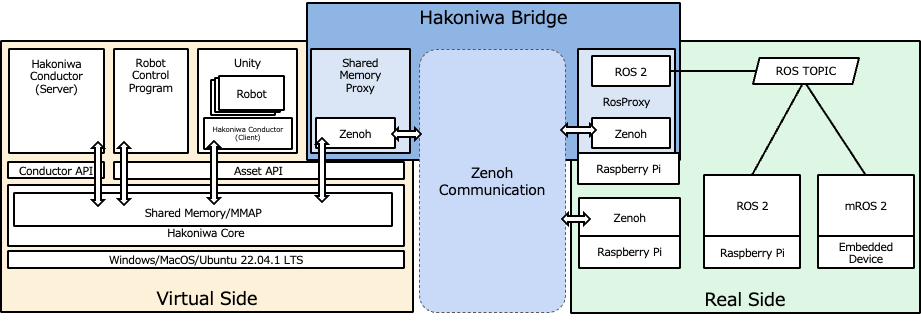English | 日本語
This repository provides "Hakoniwa Bridge," a communication module that connects the real (edge) and virtual (Hakoniwa) environments.
Hakoniwa Bridge offers the following features:
- Deliver data from the virtual side to the edge side.
- Subscribe to data from the edge side on the virtual side.
Communication in Hakoniwa Bridge is based on Zenoh.
The functionalities of Hakoniwa Bridge are broadly divided into two:
- ShmProxy
- RosProxy
ShmProxy (SharedMemoryProxy) is located on the virtual side, converting Hakoniwa PDU data into Zenoh communication data for data transfer.
RosProxy is located on the edge side, converting ROS communication data into Zenoh communication data to connect both sides. If Zenoh is integrated on the edge side, it can directly access Hakoniwa PDU data.
The reasons for adopting Zenoh are as follows:
- Offers a variety of communication methods such as UDP, TCP, ROS, MQTT, etc.
- Supports multiple programming languages (C, Python, Rust, etc.)
- Capable of bridging different networks (including ROS communication via 5G routers)
- Provides low-latency communication suitable for real-time applications
- Virtual side:
- Ubuntu, MacOS
- Edge side:
- Ubuntu
- Devices capable of integrating ROS or Zenoh (such as Raspberry Pi)
You can find the sample program here.
Clone the Hakoniwa Bridge repository:
git clone --recursive https://github.com/toppers/hakoniwa-bridge.git
Follow these steps for installation:
For the virtual side:
For the edge side:
Follow the installation instructions for the core functionalities.
- Change directory
cd third-party/hakoniwa-core-cpp-client
- Build
bash build.bash
- Install
bash install.bash
The Zenoh used by Hakoniwa Bridge is zenoh-c.
It needs to be installed on both the virtual and edge sides.
- Change directory
cd third-party
- Build
mkdir -p build && cd build
cmake ../zenoh-c
cmake --build . --config Release
- Install
cmake --build . --target install
Upon success, the following files will be created:
% ls /usr/local/include
zenoh.h zenoh_commons.h zenoh_concrete.h zenoh_configure.h zenoh_macros.h zenoh_memory.h
% ls /usr/local/lib
libzenohc.dylib
cd hakoniwa-bridge/virtual
bash build.bash
Upon success, the following file will be created:
% ls cmake-build/shm-proxy/shm-proxy
cmake-build/shm-proxy/shm-proxy
To create RosProxy, first, you need to prepare the ROS message definition files used as Hakoniwa PDU data. For simplicity, this explanation assumes the use of the following standard ROS messages:
- geometry_msgs/Twist
- std_msgs/Bool
- Change directory
cd hakoniwa-bridge/third-party/hakonwia-ros2pdu
- Create Hakoniwa PDU data
For this instance, we are using standard ROS messages, so you can use the existing Hakoniwa PDU data. If you are using custom ROS messages, follow the instructions here to create them.
- Create a config file
This file is automatically generated when you Generate in Hakoniwa's Unity editor. If you do not use Unity or if you do not share
all the PDU data with the edge side even when using Unity, you need to edit the file manually.
Place the config file as follows:
hakoniwa-ros2pdu/config/custom.json
Example definition:
https://github.com/toppers/hakoniwa-digital-twin/blob/main/digital/config/custom.json
For more details on custom.json's definition, see here.
Note, always specify SHM for method_type. Also, class_name and conv_class_name do not need to be set.
- Create RosProxy
Run the following command to generate the code for RosProxy:
bash create_proxy_ros_zenoh.bash ./config/custom.json
Upon success, the following files will be created:
# ls workspace/src/hako_ros_proxy/src/gen/
hako_ros_proxy_com_ros2.cpp hako_ros_proxy_com_zenoh.cpp
- Build RosProxy
cd workspace
colcon build --packages-select hako_ros_proxy
Upon success, the following log will appear:
Starting >>> hako_ros_proxy
[Processing: hako_ros_proxy]
Finished <<< hako_ros_proxy [35.4s]
Summary: 1 package finished [36.0s]
Usage of ShmProxy:
Usage: ./cmake-build/shm-proxy/shm-proxy <asset_name> <config_path> <delta_time_msec> [master]
ShmProxy includes the Hakoniwa Conductor. If you do not launch the Hakoniwa Conductor separately, you can use the master option to drive it.
Example of execution without the master option:
./cmake-build/shm-proxy/shm-proxy ShmProxy ../third-party/hakoniwa-ros2pdu/config/custom.json 20
Example of execution with the master option:
./cmake-build/shm-proxy/shm-proxy ShmProxy ../third-party/hakoniwa-ros2pdu/config/custom.json 20 master
source install/setup.bash
ros2 run hako_ros_proxy hako_ros_proxy_node
